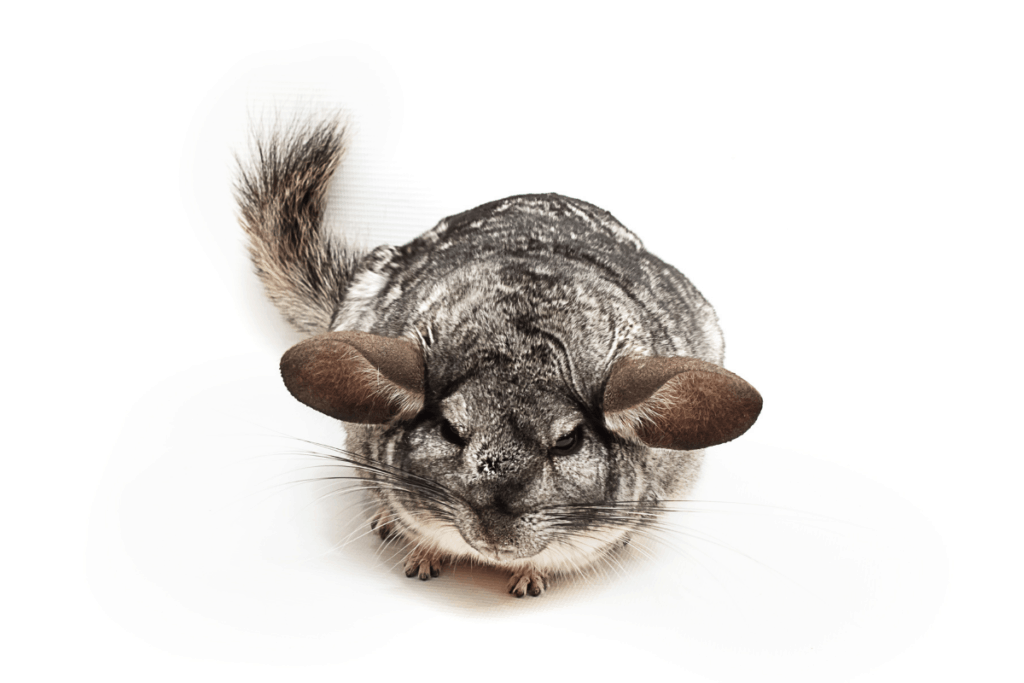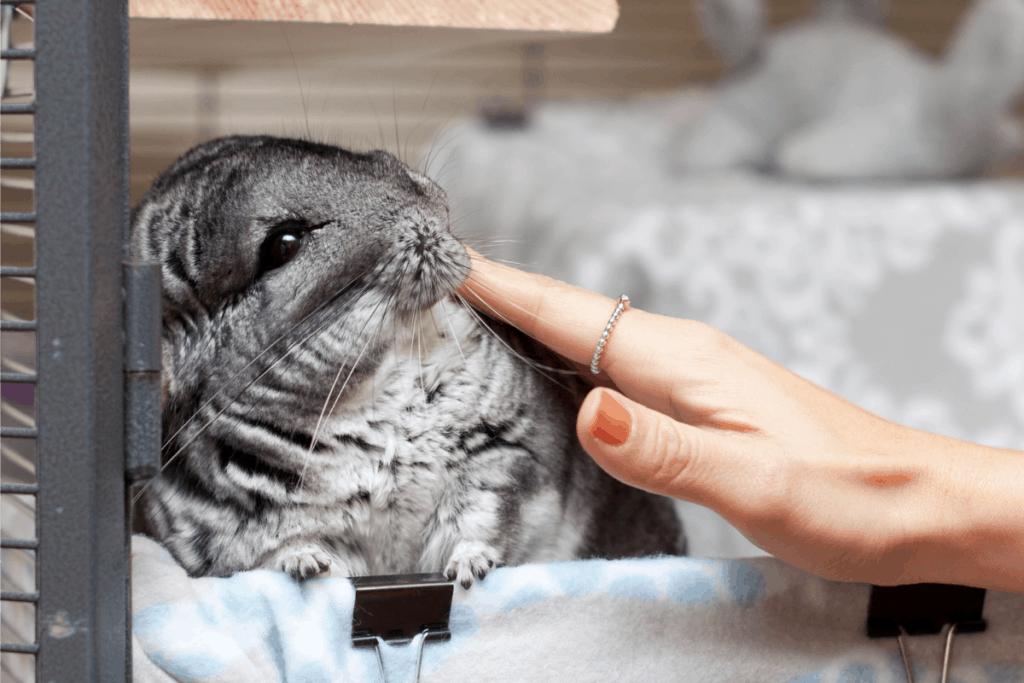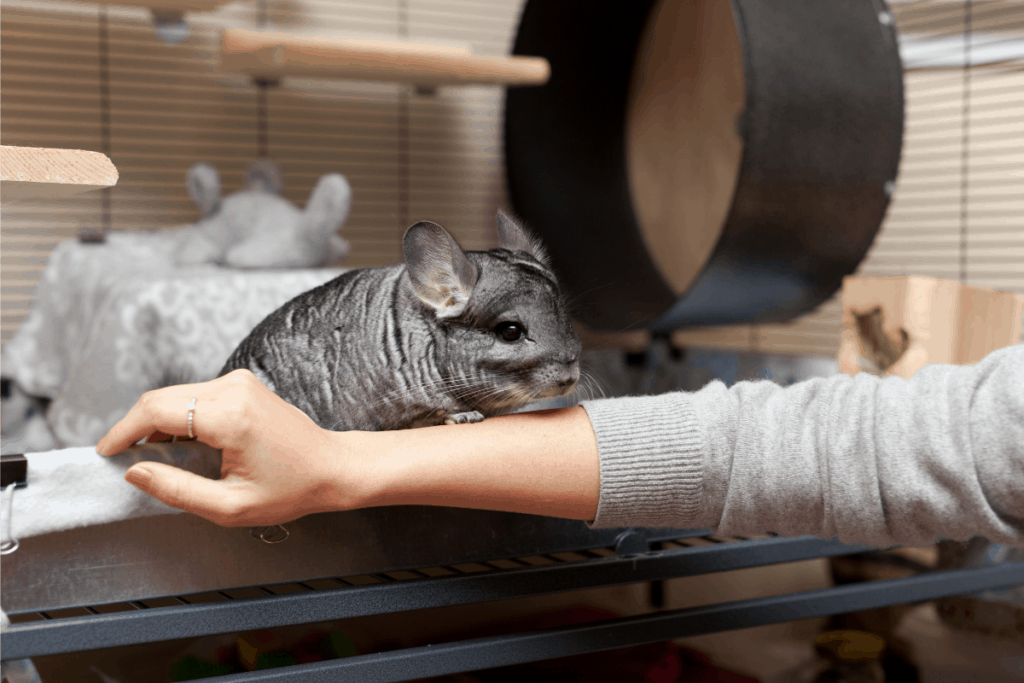Chinchillas are amazing and loving pets, but they do have a tendency to scare easily, and when they’re scared, they’ll often try to protect themselves. But how exactly do they do this?
Chinchillas defend themselves by using methods such as urine spraying, fur slipping, barking, jumping, biting, and escaping. These tactics developed in the wild to protect against predators, and are still occasionally seen in domesticated chinchillas.
In this article, I’ll discuss the different techniques chinchillas use to avoid being eaten by predators, and how to best care for a chinchilla so they won’t feel the need to defend themselves when living with you, in captivity.

Chinchillas have evolved to perceive any sudden movements as a threatening predator, and because of this, chinchillas are often seen as anxious animals. If threatened, they will use some defensive, (and occasionally offensive), methods (even in captivity, even in a loving home).
Unfortunately, this can continue for a while, until they are really comfortable with their owners. So, in order to successfully integrate a pet chinchilla into a home, it’s imperative that a new chin owner knows how to recognize these protective tactics, and what to do in order to make the chinchilla comfortable in their new environment.
In The Wild
Chinchillas are native to the Andes Mountains in South America, and in their native habitat, they usually live in herds or large groups of other chinchillas. This is partly because they are social animals, but also because it adds an extra layer of protection from predators.
Chinchillas use a “strength in numbers” approach to surviving predator attacks in the wild.
Unfortunately, chinchillas have a large number of common predators in the wild, facing threats from the sky, such as hawks and owls, while also defending themselves against cougars, foxes, and snakes on the ground.
Chinchillas also have a long history of being hunted by humans, as their fur is incredibly soft and beautiful. While measures have been taken to try to decrease the poaching of chinchillas for their fur, humans have been a huge factor in decreasing the natural chinchilla population.
There will be slight variations in the behaviors that different chinchillas will exhibit. Some will be more defensive-minded, and others more offensive. Below I’ll break down what some of these look like, and how to recognize them in a chinchilla
Defensive Behaviors

The actions that fall into the defensive category are fur slips, jumping, escaping, and barking.
Fur Slip
The fur slip is a very unique method used by chinchillas in an attempt to escape predators. If a chinchilla is grabbed or bitten by a predator, they are able to release a small patch of fur (usually into the predator’s mouth) which will often buy them enough time to successfully escape.
Chinchillas will also do this in captivity if they are mishandled, or even bump into something unexpected. Even though there is no actual threat, they will still react as though there is.
The fur slip causes no harm to the chin, and the fur does eventually grow back – it just might look a bit ‘tufty’ and scruffy for a while if a large amount is ‘slipped’.
Jumping
Chinchillas are also known to utilize jumping as a defensive tactic when they are trying to avoid a predator. Even though chinchillas are very small, they can actually jump up to 6 feet in height – this is obviously incredibly useful when trying to escape a potential attack.
As a chinchilla owner, you’ll be able to recognize when your chin is likely about to jump, as they tend to stand up really tall first, probably in order to gauge where they’re going to jump to. Because of this jumping ability, chinchillas are sometimes referred to as ‘rockhoppers, as they’ll bounce upwards across rocky outcrops to evade predators.
Jumping high doesn’t hurt them in any way but, as an owner, you need to make sure that when they reach the top of the cage they have a safe way to return to the ground, as they’ll sometimes miss their footing and plummet downwards.
The best method to safely slow your chinchilla’s fall is to create ‘staging areas’ with staggered branches, shelves, tunnels, hammocks, bridges, or even toys to slow their descent.
Escaping
In a similar vein, if a chinchilla feels threatened it will simply try to escape. This may seem obvious, but it is actually a very useful defensive mechanism for these animals.
They are incredibly quick and agile, so can be very elusive to a predator (or even a well-meaning chinchilla owner). They will also tuck their tails in, giving the predator less to “grab” on to.
Chinchilla owners should therefore take special care to try to limit the number of spaces that their chin can disappear to if it’s feeling fearful.
Because these animals are so agile, they can easily find very small hiding spots if they are feeling threatened, so an owner may need to “chinchilla proof” their home if they are getting the chin out for any reason, especially playtime, to prevent an escape.
Trust me on this, they can hide for hours – they’ll often just find a dark place and go to sleep, whilst you stress about finding them. Better to block off everything and anything you can think of before you get them out!!
Barking
Barking is another method chinchillas will use defensively. In the wild, chinchillas will bark for many reasons. Often, the goal is to ward off predators, but barking is also used to signal distress, or to warn other chinchillas of a predator.
Sometimes barking is used as a display of dominance towards other chinchillas, and because of this, it falls somewhere between defensive and offensive behavior.
A chinchilla’s bark sounds a little bit like the typical noise you would hear from a dog, except it’s usually a little more high pitched. If you hear your chinchilla barking, it typically means they are distressed, or anxious about something in their environment.
Take a few moments to investigate, as the last thing you want to do is cause them to become stressed.
Offensive Behaviors
There are two offensive tactics that chinchillas use, and these are spraying and biting. These are considered to be aggressive, or attack-minded, which is why they fall into the offensive category.
Urine Spraying
Urine spraying is a method used by chinchillas when they perceive a threat. They will simply direct a spray of foul-smelling, strong urine in the direction of the threat. Unfortunately, this is sometimes simply just an unlucky chinchilla owner trying to care for their pet.
Both male and female chinchillas will spray, but females are known to do it most often, and with more accuracy. In order to avoid being on the receiving end of this unsavory behavior, it’s important as a chin owner to recognize the signs and causes of spraying (although there’s no guarantee you’ll avoid it, even if you spot the signs).
Chinchillas will sometimes go into a warning stance before spraying, shifting to their hind legs and directing their pelvis in the direction they would like to spray in. However, a chin will not always give this warning, and some will simply spray instantaneously when they feel threatened.
A chinchilla owner should be aware of spraying behavior and make every effort to not startle their pet, in order to avoid being sprayed upon. However, this is a common occurrence, and an owner should be aware that there is always a possibility of this happening if a chinchilla is startled!
Biting

Like many animals, chinchillas will bite if they are feeling threatened or scared. This happens often when an inexperienced chinchilla owner holds their pet incorrectly, picks them up with little to no warning, or thrusts objects into their faces (such as hands, food, treats, toys, etc).
While biting tends to be a chinchilla’s last choice, they will resort to this tactic if they’re unable to attempt any of the ‘defense mechanisms’ listed above, OR if they’ve tried them, and the ‘predator’ hasn’t given up.
That being said, their teeth are very long and sharp, and getting bitten by a chinchilla can be incredibly painful. If the bite breaks the skin, the wound could develop an infection, so you should wash it under cold water, encourage it to bleed freely, then apply an antiseptic cream (and dressing if required).
Chinchillas will occasionally bite each other too (sometimes even if they have lived with their cage-mate for years), and these wounds can also become infected.
If you think there may have been biting, look out for any oozing or bleeding wounds, or any abnormal movements of the bitten chinchilla (such as limping, or favoring an area), and if you are at all worried, you should seek veterinary advice.
The best way to avoid a chinchilla biting is to use slow and clear movements when picking them up.
What Scares Chinchillas, And How To Avoid Scaring Them?
On the whole, chinchillas are very fearful and “jumpy” animals, basically because of the large number of threats they face in their natural habitat.
All of the defensive tactics listed above stem from a chinchilla being startled or scared. So as a chinchilla owner, one of the most valuable lessons to learn is how to avoid scaring a chinchilla and, in turn, avoid a urine spray, or bite.
The best practice is to avoid suddenly grabbing a chinchilla, as they need to feel comfortable, and not startled.
Use Slow Movements When Interacting With Chinchillas
Slow, and noticeable movements are the best way to interact with your chinchilla, even if they’ve become used to you – their prey instinct will always be there and can result in them being startled.
Never grab, or try to pick up a chinchilla suddenly, and always try to move in such a way that is gradual and deliberate. This will ensure that the chinchilla is not surprised or startled by your actions or by you handling them.
Use Patience To Gain Your Chinchilla’s Trust
The other way to avoid scaring a chinchilla is simply to gain their trust. This will take a fair bit of time and patience, but if you are careful with your actions, then your chin will eventually feel comfortable and come to trust you.
An example where you’ll need a fair bit of patience initially is trying to get your chinchilla out of their cage – this is probably the hardest task you’ll face. You want them to trust you, and not run to hide whenever you approach, so this one is worth taking time over:
Getting your chinchilla out of their cage
In order to get your chinchilla out of their cage without stressing them out (at which point they’ll not want to come out again), you should rest your hand/arm on the edge of the cage (rather than thrusting your hands into the cage), and allow your chin to approach you.
Keep your arm there for as long as it takes, (don’t try to grab the chin), and eventually, they’ll run up your arm when they choose to. Because of their nature, you’ll probably need a lot of patience initially, but the rewards are worth it!

Why Doesn’t My Chinchilla Trust Me?
Ultimately, chinchillas are really sensitive creatures. Some people say they’re neurotic, but that’s not generally the case. They just have a really strong prey mentality, and have developed various methods to try to ensure they stay safe.
If your chinchilla is jumpy or scared around you, it’s good to remember that these protective behaviors shown by chinchillas are a result of them having many predators in the wild, and not necessarily a reflection of how they feel about you!
Chinchillas need to feel safe and cared for in their environment, so a good owner will make sure they are aware of what will trigger their chin to go into a defensive (or offensive) mode, and will try to minimize these situations wherever possible.
Of course, there are always unpredictable circumstances, so even if a chinchilla is very well adjusted and happy in its environment, some of these defensive tactics may still be used occasionally. This is common and not something to worry about unless it happens all the time.
In summary, time and patience are the keys to successfully winning the trust of your chinchilla. As long as you keep in mind that you are big and scary to them, and treat them gently, you’ll have a trusted companion in no time.
